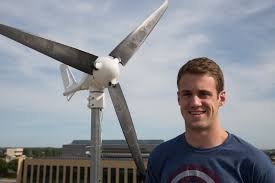Ben Rorem
 Ben writes: In the summer of 2016, I conducted research with my advisor, Dr. Charles Niederriter, and my colleague, Rochelle Widmer '17, on a system designed to increase wind speeds, thus enabling the production of significant power from small wind turbines.
Ben writes: In the summer of 2016, I conducted research with my advisor, Dr. Charles Niederriter, and my colleague, Rochelle Widmer '17, on a system designed to increase wind speeds, thus enabling the production of significant power from small wind turbines.
If this system were economic, wind farms could use smaller turbines with the same power output as those with large turbines. We finished construction of a prototype that autumn with the help of Jill Malecha '17, hoping to obtain data the following spring. Unfortunately, the winter winds then destroyed our progress and the system was rebuilt during spring break. The data acquired in the following months did not produce conclusive results before the system had to be deconstructed. We concluded that, given the available budget, the system was too fragile to be viable. Although the project was hardly conclusive, the process was a valuable example of the complexities and effort that come with research.
In summer 2018, I conducted research with four graduate students and Prof. Kakalios at the University of Minnesota – Twin Cities. Nanocrystals, crystals around the size of a nanometer, are a relevant research topic for climate change because of their potential viability in solar energy.
Cheaper silicon solar cells use amorphous silicon, which is a spray-painted coat of atoms, and have a lower energy efficiency. Crystalline silicon solar cells are more expensive, but have significantly higher energy efficiency. The question is if nanocrystalline silicon is a happy medium between amorphous and crystalline silicon, making solar energy more affordable and efficient. In my research, I studied various thin films of these nanocrystals, and how they conducted electricity. Overall, more characterization of such materials is needed to advance viability in industrial settings.